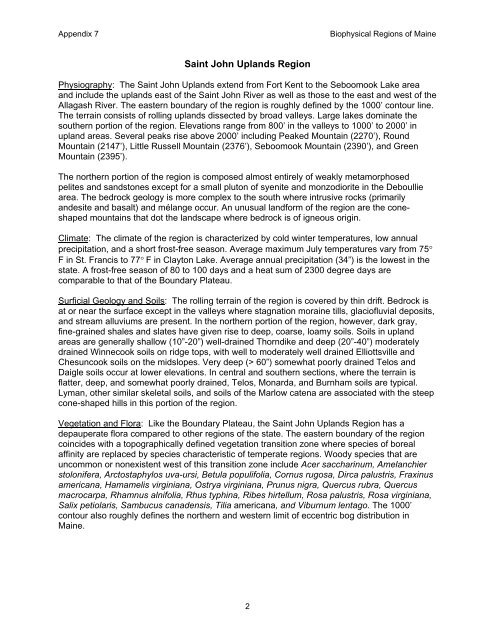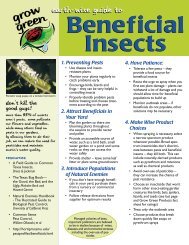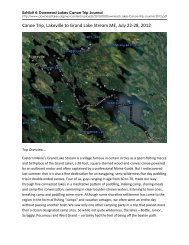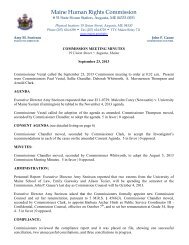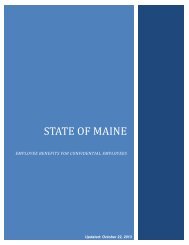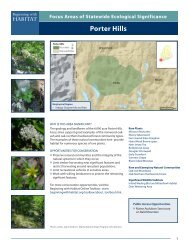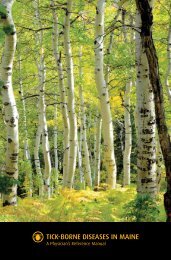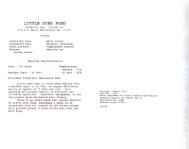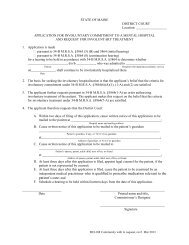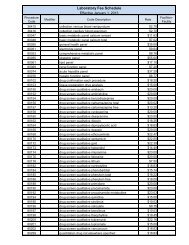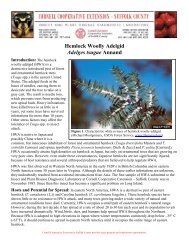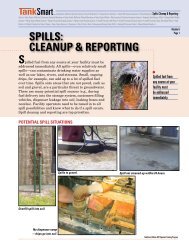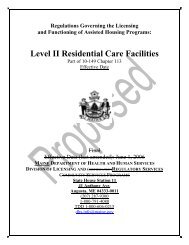BIOPHYSICAL REGIONS - Maine.gov
BIOPHYSICAL REGIONS - Maine.gov
BIOPHYSICAL REGIONS - Maine.gov
Create successful ePaper yourself
Turn your PDF publications into a flip-book with our unique Google optimized e-Paper software.
Appendix 7 Biophysical Regions of <strong>Maine</strong><br />
Saint John Uplands Region<br />
Physiography: The Saint John Uplands extend from Fort Kent to the Seboomook Lake area<br />
and include the uplands east of the Saint John River as well as those to the east and west of the<br />
Allagash River. The eastern boundary of the region is roughly defined by the 1000’ contour line.<br />
The terrain consists of rolling uplands dissected by broad valleys. Large lakes dominate the<br />
southern portion of the region. Elevations range from 800’ in the valleys to 1000’ to 2000’ in<br />
upland areas. Several peaks rise above 2000’ including Peaked Mountain (2270’), Round<br />
Mountain (2147’), Little Russell Mountain (2376’), Seboomook Mountain (2390’), and Green<br />
Mountain (2395’).<br />
The northern portion of the region is composed almost entirely of weakly metamorphosed<br />
pelites and sandstones except for a small pluton of syenite and monzodiorite in the Deboullie<br />
area. The bedrock geology is more complex to the south where intrusive rocks (primarily<br />
andesite and basalt) and mélange occur. An unusual landform of the region are the coneshaped<br />
mountains that dot the landscape where bedrock is of igneous origin.<br />
Climate: The climate of the region is characterized by cold winter temperatures, low annual<br />
precipitation, and a short frost-free season. Average maximum July temperatures vary from 75°<br />
F in St. Francis to 77° F in Clayton Lake. Average annual precipitation (34”) is the lowest in the<br />
state. A frost-free season of 80 to 100 days and a heat sum of 2300 degree days are<br />
comparable to that of the Boundary Plateau.<br />
Surficial Geology and Soils: The rolling terrain of the region is covered by thin drift. Bedrock is<br />
at or near the surface except in the valleys where stagnation moraine tills, glaciofluvial deposits,<br />
and stream alluviums are present. In the northern portion of the region, however, dark gray,<br />
fine-grained shales and slates have given rise to deep, coarse, loamy soils. Soils in upland<br />
areas are generally shallow (10”-20”) well-drained Thorndike and deep (20”-40”) moderately<br />
drained Winnecook soils on ridge tops, with well to moderately well drained Elliottsville and<br />
Chesuncook soils on the midslopes. Very deep (> 60”) somewhat poorly drained Telos and<br />
Daigle soils occur at lower elevations. In central and southern sections, where the terrain is<br />
flatter, deep, and somewhat poorly drained, Telos, Monarda, and Burnham soils are typical.<br />
Lyman, other similar skeletal soils, and soils of the Marlow catena are associated with the steep<br />
cone-shaped hills in this portion of the region.<br />
Vegetation and Flora: Like the Boundary Plateau, the Saint John Uplands Region has a<br />
depauperate flora compared to other regions of the state. The eastern boundary of the region<br />
coincides with a topographically defined vegetation transition zone where species of boreal<br />
affinity are replaced by species characteristic of temperate regions. Woody species that are<br />
uncommon or nonexistent west of this transition zone include Acer saccharinum, Amelanchier<br />
stolonifera, Arctostaphylos uva-ursi, Betula populifolia, Cornus rugosa, Dirca palustris, Fraxinus<br />
americana, Hamamelis virginiana, Ostrya virginiana, Prunus nigra, Quercus rubra, Quercus<br />
macrocarpa, Rhamnus alnifolia, Rhus typhina, Ribes hirtellum, Rosa palustris, Rosa virginiana,<br />
Salix petiolaris, Sambucus canadensis, Tilia americana, and Viburnum lentago. The 1000’<br />
contour also roughly defines the northern and western limit of eccentric bog distribution in<br />
<strong>Maine</strong>.<br />
2


